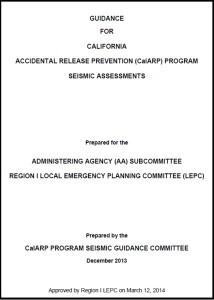Overview of Federal and California Process Safety Regulations (Part 3 of 3)
This is a continuation of our blog series titled Overview of Federal and California Process Safety Regulations. Part 1 and Part 2 of our series can be accessed here and here.
RMP vs. CalARP
The California Accidental Release Prevention (CalARP) regulation is similar to USEPA’s Risk Management Program (RMP) with a few exceptions. The following is a summary of important differences to be aware of:
Threshold Quantities and Chemical List – In general, CalARP threshold quantities are much lower than RMP for the same chemical and the list of covered chemicals is much longer (see Table 3 of CalARP regulation). For example, in the case of anhydrous ammonia the threshold quantity is 500 lb in CalARP compared to 10,000 lb in RMP.
External Events – CalARP requires that all PHAs and Hazard Reviews “include the consideration of external events, including seismic events, if applicable.” [Title 19 CCR §2760.2(c)(8) and Title 19 CCR §2755.2(d)]. RMP has no such requirement. Furthermore, Region 1 LEPC has developed a guidance document, Guidance for California Accidental Release Prevention (CalARP) Program Seismic Assessments, to further describe the best practices for performing a seismic assessment in conjunction with a PHA or Hazard Review.
CUPA Coordination –The CalARP regulation is enforced at the local level by the Administering Agency (AA), commonly referred to as the Certified Unified Program Agency (CUPA). In general, each of California’s 58 counties has its own CUPA which is responsible for overseeing the implementation of a CalARP program and providing enforcement if necessary. Title 19 CCR §2785.1(a) requires that “the owner or operator of a stationary source shall closely coordinate with the AA [CUPA] to ensure that appropriate technical standards are applied to the implementation of this chapter.” Close coordination with the CUPA/AA is also required in Title 19 CCR §2735.5(a), §2745.2(a)(1), §2745.6(l)(2), §2745.7(q)(2), and §2760.2(b). CUPAs make working as a consultant in California interesting because each county tends to have its own interpretation on proper implementation of CalARP program elements. Below are hyperlinks to several CUPA websites which illustrate these differences:
- Contra Costa County Health Services
- Los Angeles County Health Hazardous Materials Division
- Kern County Public Health Services – Hazardous Materials CUPA
- San Joaquin County Environmental Health Department CUPA
CalARP Review and Submission Process – The CalARP regulation (§2745.2) outlines a review process which must be performed on each Risk Management Plan that is submitted to the CUPA. A summary of the requirements of the review and submission process includes:
- Certification – A qualified person must certify the Risk Management Plan as complete. This certification is in addition to the certification required in Title 40 CFR §68.185 and Title 19 CCR §2745.9. The regulation defines “qualified person“, but ultimately the CUPA must agree that the certifying person meets that definition.
- Public Review – After the Risk Management Plan is determined to be ‘complete’ by the CUPA, the CUPA must make the document available for public review and comment. Several CUPAs do this by placing a notice in a local newspaper or using their website.
- Public Access – The public is allowed access to all Risk Management Plan info submitted to the CUPA.
- Submission – The submission requirements of the Risk Management Plan to the CUPA are so similar to the USEPA, that often facilities will use there RMP eSubmit report generated from the CDX portal as the CalARP Risk Management Plan submittal. This method can work for a process that is subject to both RMP and CalARP, but no such web portal is available for a process that is only subject to CalARP. In this instance, an independent Risk Management Plan submission document must be prepared and submitted to the CUPA per their specific submission protocols.
Due to the variation in threshold quantities between CalARP and RMP (for ammonia 500 lb vs.10,000 lb), smaller ammonia systems are often subject to the Program 2 Prevention Program requirements. In general, an RMP ammonia process (>10,000 lb) would never be considered Program 2 because that process would also be subject to PSM. The Program 2 elements are sometimes referred to as PSM-lite, and include the following elements:
- Safety Information
- Hazard Review
- Operating Procedures
- Training
- Maintenance
- Compliance Audits
- Incident Investigations
Notice that the MOC, PSSR, Contractors, etc. Prevention Program elements are not required for a Program 2 process. However, it is important to understand that some of the requirements of these missing elements are still applicable because they have been buried within specific Program 2 Prevention Program elements. For example:
- Safety Information §2755.1(c)The owner or operator shall update the safety information if a major change occurs that makes the information inaccurate. [Similar to MOC requirements]
- Maintenance §2755.5(c)Any maintenance contractor shall ensure that each contract maintenance employee is trained to perform the maintenance procedures developed under section (a). [Similar to Contractor requirements]
- Training §2755.5(d) The owner or operator shall ensure that operators are trained in any updated or new procedures prior to startup of a process after a major change. [Similar to PSSR requirement]
Summary
I trust this blog series has been helpful in providing an overview of the requirements of RMP and PSM at the Federal and California-state level. Navigating the various requirements can be confusing, making it critical to break the regulations down into individual components to help determine if compliance is being achieved.


Leave a Reply